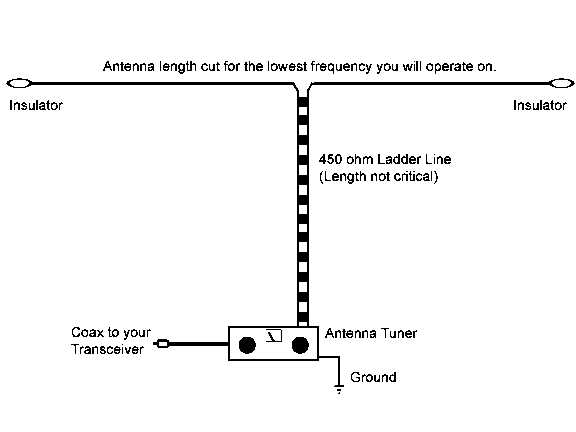450 Ohm Ladder Line
This is a type of twin lead wire used as a transmission line to carry radio energy. It is constructed of two multi-stranded copper or copperclad steel wires, held a precise distance apart by a spacer ribbon. The uniform spacing of the wires is the key to the cable's function as a parallel transmission line. If the spacing is not maintained then rf energy is reflected backwards to the transmitter.
Traditional VHF television installations from prior to the digital conversion used 300-ohm ladder line. The standard in HAM radio for HF operation is 450-ohm. This is a measurement of the impedance of the line. As a transmission line, transmission efficiency will be maximum when the impedance of the antenna, the characteristic impedance of the twin-lead line and the impedance of the equipment are the same.
- 450 Ohm Ladder Line is also known as Window Line or ladderline (one word).
- 450 Ohm Ladder Line is a type of balanced line
- Coaxial cable is a type of unbalanced line.
Coax cable has a much higher loss per unit length than open wire line or window line. For HF ham radio operation the loss of window or ladder line is so low that even at high SWR, the excess loss is rarely noticeable. So balanced line, even with a high SWR, can outperform coax which is perfectly matched.
Using Ladder Line in Ham Radio
Because balanced transmission line has relatively low loss even at high SWR, the match at the feed point is not critical for HF operation. The impedance at the input to any transmission line will be the characteristic impedance of the transmission line only when the transmission line is terminated in the line's characteristic impedance.
As long as the length of the antenna is at least a half-wavelength at its lowest intended frequency, its efficiency is well over 90% even if not well resonant. Can an antenna be a good radiator of signal if not "resonant?" The answer is "yes." When using ladder line it is important to use an antenna tuner.
Considerations
- Where to place the balun - depends on factors however the antenna tuner has a balun internally.
- Use of antenna tuner - definitely, if you plan to transmit!
- Impedance matching significance - not so important as some would preach. This isn't television!
- Ladder line radiation factor - ladder line does not radiate any appreciable amount.
- Twisting - Windowed line should be twisted about one twist for every two feet to prevent wind-induced oscillations.
Doublet Antenna -w- ladder line
An antenna tuner with a built in balun matches the feed-line impedance to the 50Ω coax of the transceiver. The length of the antenna is for the lowest frequency that it will be used on at ½ wavelength. It wills serve for higher frequencies above the lowest match. Never install a balun between the ladder line and the antenna at the feedpoint since they already have the correct match.
Estimations:
- 160m (1.8 Mhz) overall length - 254' from insulator to insulator.
- 80m (3.5 Mhz) overall length - 134' from insulator to insulator.
- 40m (7.0 Mhz) overall length - 67' from insulator to insulator.
Length here is from end to end, including both ends of the dipole. Simply divide by 2 to determine the wire length for each pole.
Basic Formula:
- Feet length = Total length - 468 / frequency
L = 468/f.
To calculate the length of each individual pole, = 234/frequency
To calculate the total length from end to end (both poles) = 468/frequency
When creating an HF antenna they say (they being experienced hams) that you should add about 2' extra to compensate for the inaccuracy of the magic number "468." According to the ARRL Antenna Book, the "end effect" due to the attachment of insulators at the ends of the antenna results in the approximately 5% reduction in length from the free-space 492/f to 468/f. The percentage varies slightly with different installation. Height of the antenna above the ground has a significant impact.
Connection:
The all band doublet antenna is a 1/2 wave dipole cut for your lowest operating frequency. It should never be connected to the tuner with coaxial cable. The best choice is 450Ω ladder line from the antenna wires to the antenna tuner. You will end up with an antenna that can be used from the lowest cut frequency up to 10-meter on your HF ham transceiver.
People have used 300Ω flat television line, however, due to the gauge of the wire this should never be used to transmit with more than 150 watts of power. The impedance issue doesn't seem to be significant according to many sources, as 300 ohm wire can work as a substitution for 450 ohm ladder line. The impedance is the result of the spacing of the twin wires. The 300 ohm television wire simple has the twin closer together. What is extremely significant is that the spacing of the twin wires is consistent.
One Wire, One Antenna:
Some hams take the 450Ω ladder line and tear one end down the middle separating the two wires for the distance equal to the length of each pole in the HF dipole. This gives them one antenna made from the same wire as the feed line. Where the separation ends is the feed point and from that point to the window the wire remains in the evenly spaced pair.
External
The lure of the ladder line by Rob Kalmeijer (WB8IMY)
